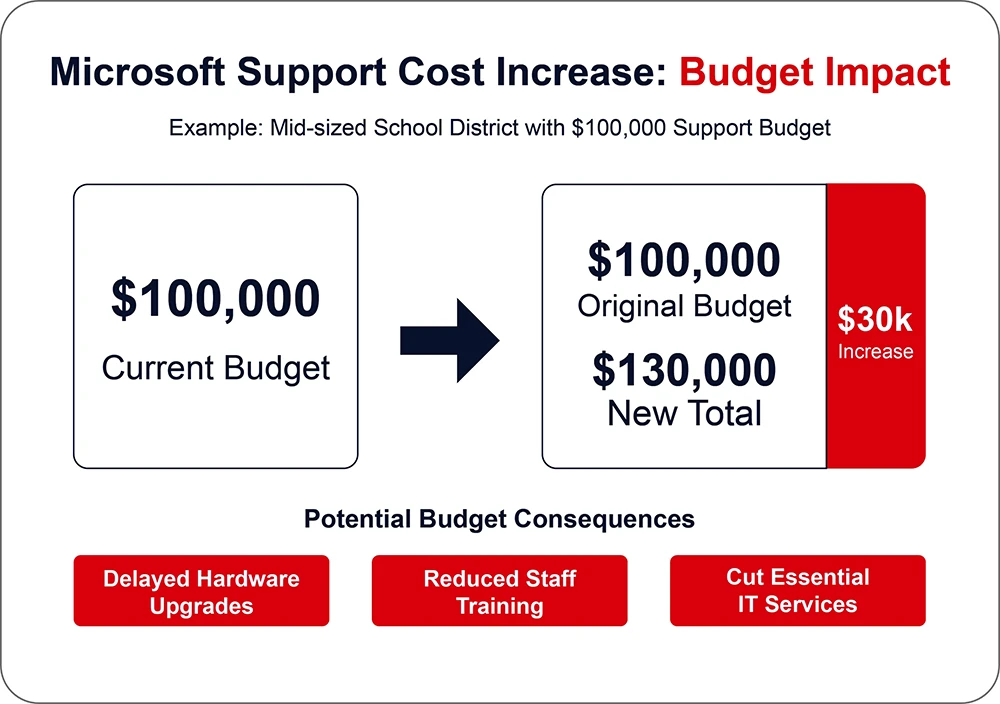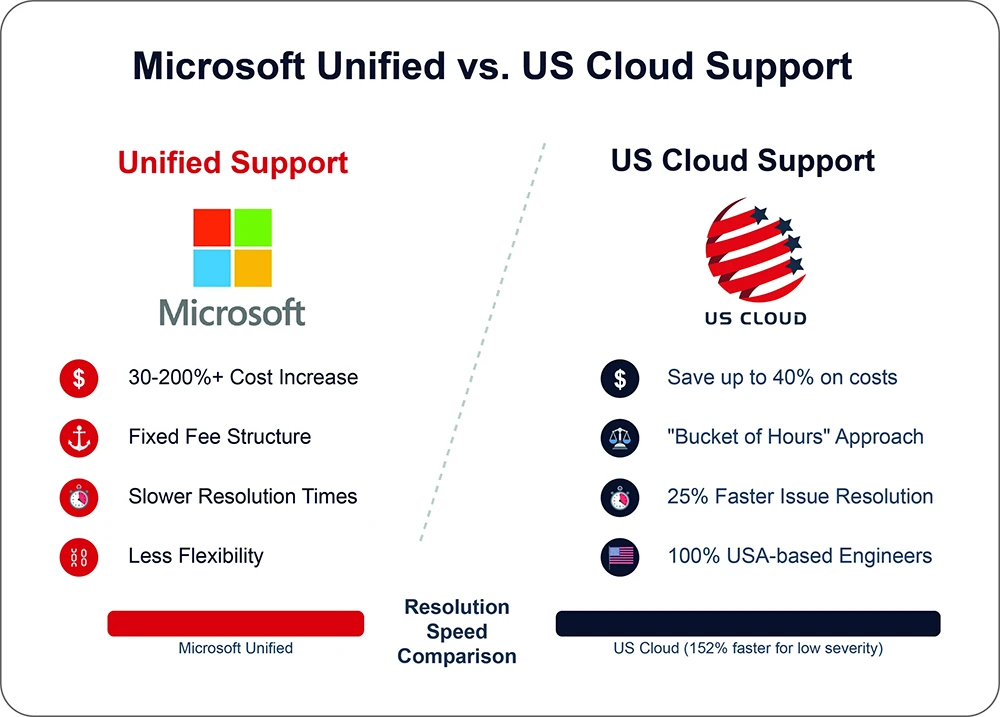
Microsoft Support Price Increase Lifeline: How IT Experts in Government & Education Can Adapt.

The Microsoft Support Landscape Shift

As an IT professional or decision-maker in the government or education sector, you’re likely facing a significant challenge: the impending increase in Microsoft support costs once Premier Support is officially outmoded. This isn’t just another budget line item; it’s a potential game-changer for your IT operations and overall institutional effectiveness.
Microsoft’s recent decision to retire its Premier Support for Education and Government Contracts in favor of a Unified Support Contract model is set to impact your organization’s bottom line substantially. With support costs potentially rising by 30% or more, you’re now tasked with maintaining critical IT infrastructure and services while navigating tighter budget constraints.
From Premier to Unified: What's Changing?
As of July 2024, Microsoft officially announced plans to retire its Premier Support for Education and Government Contracts. This move marks a significant shift in how these institutions access high-level IT support. The new Unified Support Contract model introduces several key changes:
- Fixed Fee Structure: Unlike the previous model where you could purchase a set number of support hours annually, the new system implements a fixed fee based on your total annual Microsoft spend.
- Potential Cost Increase: Many organizations are reporting expected cost increases of 30% or more under the new model.
- Less Flexibility: The transition away from an hours-based consumption model means less ability to adjust support levels based on changing needs or budget constraints.
- Standardized Support Packages: The new model offers less customization, potentially leading to paying for services you may not need.
Whether you’re a small school district, a large university, or a government agency, understanding these changes and your options is crucial for making informed decisions about your IT support strategy.
Timeline of Support Plan Changes
To better understand the transition, let’s look at a brief timeline:
- 2019: Microsoft announces the eventual retirement of Premier Support contracts.
- 2020-2023: Gradual transition period for commercial customers.
- July 2024: Official retirement of new or renewing contracts for Premier Support for Education and Government Contracts.

This timeline highlights the importance of acting now, because once current Premier Support contracts end, customers will be automatically enrolled in Unified Support. Especially as many institutions may find themselves caught off-guard by the sudden increase in support costs.
Impact on Government and Education Sectors
The shift to Unified Support Contracts is poised to have far-reaching implications for government and education entities.
One of the biggest questions in this transition is how it affects support costs. Various industry analysts and customer reports have suggested that moving to Unified Support substantially increases support expenses – often on the order of 25–30% or more. Gartner’s analysis early in the rollout indicated that a typical organization “paying about 7% of annual [Software Assurance] cost for Premier Support will see a 25% to 30% cost increase for Unified Support.”

It’s important to note that the exact increase varies by organization. Those who previously kept support spending very low (relative to their Microsoft license spend) tend to see the biggest jumps. Independent Microsoft licensing experts report “the average increase in price is 30% – 200%+ with the switch from Premier Support,” with smaller organizations or those who heavily leveraged free support credits seeing higher percentage spikes.
In the early phases of Unified Support, some enterprise customers experienced sticker shock with support proposals rising anywhere from 50% to 300% until Microsoft provided temporary discounts to ease the transition. Education and government institutions that stick to the minimum service may see increases closer to the 30% range, while others with specific situations (loss of credits or low previous spend) could see even larger jumps.

Budget Strain
Government and education institutions are facing significant budget challenges due to increases in Microsoft support costs.
- Microsoft Office 365 G1 prices for the public sector are set to increase by 10% in March 2024, followed by another 5% increase in March 2025.
- Enterprises that moved to Unified in 2021 are reporting roughly 28% year-over-year support cost increases in their second year of Unified (once initial discounts expired)
These increases can have substantial impacts on IT budgets: for a mid-sized school district with a $100,000 Microsoft support budget, even 10% increase would mean an additional $10,000 in costs.
This extra expense could force difficult decisions, such as:
- Delaying hardware upgrades
- Reducing staff training budgets
- Cutting other essential IT services
As public sector organizations face increasing scrutiny on government spending, these rising costs present a significant challenge for IT departments trying to maintain services while managing tighter budgets.
Reduced Flexibility
The shift from Premier to Unified Support has significant implications for budget management:
- No more hours-based support models, limiting ability to adjust support levels as needed, which is particularly challenging for educational institutions with seasonal support needs (e.g., enrollment periods)
- Fixed fee structure based on total annual Microsoft spend
This change means organizations can’t easily scale support up or down to match their fluctuating needs throughout the year.
Planning Challenges
The timing of Microsoft’s support model transition poses difficulties for many institutions:
Typical budget planning occurs December-January for fiscal years starting in June/July. And since the expiration of Premier Support contracts for certain federal institutions may not align with this standard financial planning period, carefully planned budgets could be disrupted. Organizations may need to reassess their IT budgets mid-cycle to accommodate the new support structure.
Potential Impact on Service Quality

While not directly tied to the pricing model, there are concerns about service quality under Unified Support:
- Standardized support may not address unique needs of government and education sectors, including compliance requirements and legacy systems
- Support staff often lacks knowledge about how to help solve Microsoft issues within the parameters of strict budgetary constraints
- Slow response and resolution times mean delays in returning service to students or constituents
- Offshored support teams typically present challenges to swift Microsoft issue resolutions
- To address these challenges, educational organizations may need to explore alternative support options or allocate additional resources to in-house IT support capabilities.
US Cloud: Cost-Effective Support Solution to Microsoft Unified Support for Educational Institutions and Government Entities
s government and education institutions face challenges with Microsoft’s new support model, here at US Cloud, we offer a compelling alternative:
Significant Cost Savings
US Cloud provides support services at a fraction of Microsoft’s Unified Support costs:
- Save up to 40% compared to current Microsoft Premier Support contracts
- Potential annual savings of tens to hundreds of thousands of dollars
- Average cost reduction of 30-50% in the first year alone
Flexible Pricing Options
Unlike Microsoft’s fixed-fee model, US Cloud offers:
- A “bucket of hours” approach, allowing you to allocate support resources as needed
- Customizable packages for comprehensive or targeted support
- Ability to add up to 50% more hours at your initial rate if needed
Whether you need comprehensive, around-the-clock support or more targeted assistance for specific systems, we can tailor a package to fit your requirements and budget.
Expertise in Government and Education
US Cloud brings extensive experience in government and education sectors:
- Deep understanding of unique challenges and compliance with regulatory requirements
- Compliance with standards like FERPA, HIPAA, and government data protection regulations
- 100% USA-based Premier Engineers with 15+ years of experience
Faster Resolution Times
US Cloud outperforms Microsoft Unified Support in ticket resolution:
- 25% faster issue resolution compared to Microsoft
- 152% faster for low severity tickets since 2023
- Guaranteed 15-minute response time for all tickets
When you choose US Cloud, government and education institutions can maintain high-quality IT support while significantly reducing costs and improving service quality. Don’t wait for Microsoft support prices to skyrocket. Schedule a call with us to learn more about how we can help your organization thrive.

Frequently Asked Questions
Why is Microsoft increasing support costs for government and education institutions?
Microsoft is retiring Premier Support and transitioning customers to its Unified Support model. This new model often results in a fixed fee based on overall Microsoft spending, which can lead to a significant price increase, especially for organizations with extensive Microsoft deployments.
What is Microsoft Premier Support, and why is it being retired?
Microsoft Premier Support was a customizable support offering that allowed organizations to purchase a specific number of support hours annually. Microsoft is retiring this model to streamline its support offerings under the Unified Support umbrella.
How much more can we expect to pay for Microsoft support under the Unified Support Model?
Many organizations report expected cost increases of 30% or more. Some enterprises have experienced roughly 28% year-over-year support cost increases after transitioning to Unified Support.
What are the key challenges of budgeting in the public sector for IT?
Public sector IT budgets are often constrained and subject to intense scrutiny. Key challenges include:
- Limited funding and resources
- Competing priorities for public funds
- Strict procurement processes
- The need to balance innovation with cost-effectiveness
Is US Cloud support compliant with government and education regulations?
US Cloud understands the unique compliance requirements of government and education institutions and is versed in standards such as FERPA, HIPAA, and various government data protection regulations.



